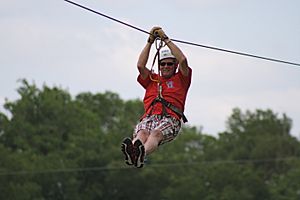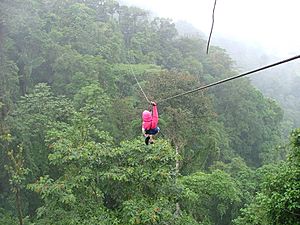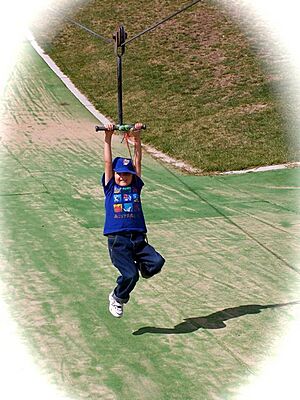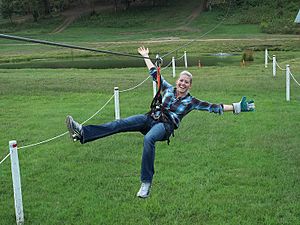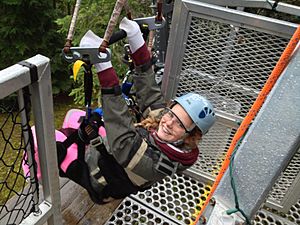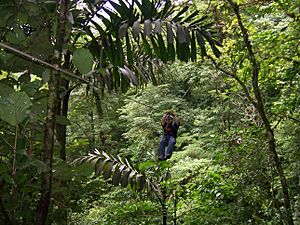Zip line facts for kids
A zip-line is a fun way to travel using a special cable. It's also called a zip line, zip-wire, or flying fox. Imagine a strong cable, usually made of stainless steel, stretched between two points, often on a slope. A small wheel called a pulley hangs from this cable.
When you ride a zip-line, you hold onto or are attached to this pulley. Gravity then pulls you down the cable from the top to the bottom. It's like a fast slide through the air! While many people think of zip-lines for adventure and fun, they have also been used for transport.
Contents
History of Zip-lines
People have used cable systems for transport for over 2,000 years. Some of the earliest ideas might have come from China, India, and Japan around 250 BC. These early systems helped move things across mountains. Not all of them used gravity like modern zip-lines do.
During the Middle Ages in Europe, these cable systems got better. Some of them did use gravity to help things move faster.
One of the first times a zip-line was used for fun was in 1739. A person named Robert Cadman, who was good at climbing tall buildings and walking on ropes, tried to slide down a rope from a church in Shrewsbury, England. Sadly, his rope broke.
Later, in a book called The Invisible Man (1897) by H. G. Wells, a "strong inclined rope" was part of a fair. This sounds a lot like an early zip-line ride.
Some people believe that today's adventure zip-lines came from special ropes used in mountaineering. These were called Tyrolean traverses. In the Australian outback, zip-lines were sometimes used to deliver important items. They helped people working in valleys get food, mail, and even supplies during conflicts.
Current Uses of Zip-lines
Zip-lines are used in many ways today. They are great for transport and also for exciting recreation.
Zip-lines for Transport
In places like Yungas, Bolivia, zip-lines help move harvested crops. They are especially useful for carrying coca across deep valleys. You can also see them used in the Ladakh region of India.
Recently, there's been new interest in using cable systems to move cargo. This is because they use less energy and are better for the environment. Gravity-powered zip-lines have been built in Nepal, Latin America, and India for this purpose.
Zip-lines for Fun
Zip-lines are very popular for adventure and play.
Playground Flying Foxes
Many children's playgrounds have smaller zip-lines. These are often called "flying foxes" in Australia, New Zealand, and Scotland. They are designed to be safe for kids. The slopes are gentle, so speeds stay low. This means kids don't usually need a special way to stop.
On playground zip-lines, the pulley is fixed to the cable. Kids usually hold onto a handle, but sometimes there's a seat or a safety strap. To bring the handle or seat back to the top, you just push or pull it up the hill.
Canopy Tours and Adventure Zip-lining
Longer and higher zip-lines are often used to explore remote areas. A great example is a rainforest canopy. In the 1970s, scientists used zip-lines to study dense rainforests in Costa Rica. This allowed them to explore without harming the environment.
This idea led to the business of zip-line canopy tours. A Canadian named Darren Hreniuk helped start these tours in Costa Rica. He wanted to use them to teach people about protecting forests.
A canopy tour takes you through a forest, often in mountains. You ride zip-lines and cross bridges between platforms built in trees. You wear a harness for safety. Many of these tours are for adults only. They can be close to the ground or high up in the treetops. Canopy tours are often part of ecotourism, which focuses on responsible travel to natural areas.
Zip-line tours are now popular vacation activities. You can find them at resorts and adventure camps. They might be part of a bigger challenge like a hike or a ropes course.
How Zip-lines Work
Understanding how zip-lines work makes them even more interesting.
The Mechanism
Zip-lines use a special kind of pulley. This pulley has a grooved wheel called a sheave. The wheel turns as it moves along the cable. This helps reduce friction, allowing you to go faster.
The "zipliner" or trolley is the part that holds the pulley. It runs along the cable. Zip-lines also have a way for you or your cargo to attach to the pulley system. This could be a harness, a seat, or even just a handhold for smaller playground zip-lines. A special clip called a carabiner often connects the harness to the pulley.
Stopping on a Zip-line
Since gravity pulls you down, the cable needs to be on a steep slope. On longer zip-lines, you often need a safe way to stop at the end. Here are some common ways zip-lines stop:
- Friction: Sometimes, the pulley creates enough friction against the cable to slow down.
- Gloves: Riders might wear thick leather gloves to create friction and slow themselves.
- Nets: A soft mat or netting at the end can catch you.
- Springs or weights: Some systems use springs, counterweights, or bungee cords. These slow and then stop the trolley.
- Capture block: A person can control a rope attached to a block on the cable. They apply friction to the rope to slow the rider down.
- Gravity stop: The cable might sag in the middle, making the end point higher than the lowest part. This natural uphill slope helps you slow down and stop.
- Hand brake: Some zip-lines have a hand brake at the end.
Zip-line Safety
Safety is very important on zip-lines. Riders are physically connected to the cable. They wear a harness that attaches to the trolley. Almost all zip-line courses require you to wear a helmet.
All zip-line cables will sag a little bit. Making sure the cable has the right amount of tension is important. This helps control how the zip-line ride feels.
Amazing Zip-line Records
Zip-lines around the world hold some incredible records!
Longest Zip-lines
As of early 2018, the world's longest zip-line is the 'Jebel Jais Flight'. It's located on the Jebel Jais mountain in the United Arab Emirates. This single zip-line stretches for about 2,831 meters (9,288 feet)! The ride was temporarily closed for a while but has since re-opened.
The "Parque de Aventura Barrancas del Cobre" in Mexico is the second-longest. It is about 2,545 meters (8,350 feet) long. "El Monstruo" in Puerto Rico is third, at about 2,530 meters (8,300 feet).
In England, the Skywire at Bluewater is the longest, at 725 meters (2,379 feet). Europe's longest zip-line is the Zip World Bethesda line in Wales. It is over 1,600 meters (5,200 feet) long. This Welsh zip-line also holds the record for the fastest zip-line travel speed!
Steepest Zip-lines
Some zip-lines are incredibly steep, giving riders a thrilling drop!
- Saint Martin's Rockland Estate Rainforest Adventures zip-line opened in 2017. It drops 320 meters (1,050 feet) over its 853-meter (2,799-foot) cable.
- The Letalnica bratov Gorišek zip-line in Slovenia is on a ski jumping hill. It is 566 meters (1,857 feet) long and drops 202 meters (663 feet). It has a very steep average incline of 38.33%.
- The ZipFlyer in Nepal claims to be the world's steepest zip-line. It has a maximum incline of 56% and a vertical drop of 610 meters (2,000 feet).
Oldest Person to Ride a Zip-line
On his 106th birthday, a British great-grandfather named Jack Reynolds became the oldest person to ride a zip-line. He did it on April 6, 2018, at Go Ape in Grizedale Forest, England.
Highest Elevation Zip-line
The La Tyrolienne in Val Thorens, France, is the highest altitude zip-line. It is located at an amazing 10,600 feet (3,231 meters) above sea level!
Images for kids
See also
 In Spanish: Tirolesa para niños
In Spanish: Tirolesa para niños
- Adventure park
- Aerial tramway
- Breeches buoy


